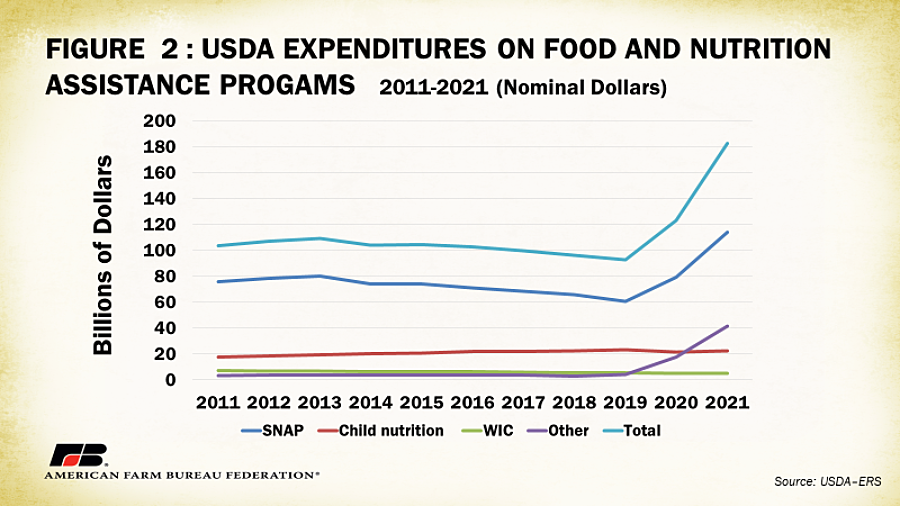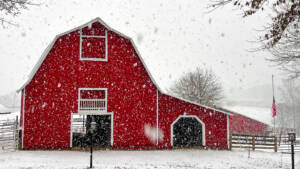Revisiting Title IV of the Farm Bill – Nutrition

photo credit: Getty Images
Bernt Nelson
Economist
Title IV of the Agriculture Improvement Act of 2018 (2018 farm bill, PL 115-334) is the nutrition title. Title IV reauthorizes several nutrition and domestic food assistance programs including the Supplemental Nutrition Assistance Program (SNAP). SNAP, formerly known as the food stamp program, is responsible for the majority of all farm bill outlays and has been authorized in the farm bill since 1973. This Market Intel will provide an overview of the programs and benefits contained in the nutrition title.
SNAP
SNAP helps many Americans across the country including the 11.6% of adults and children in rural counties affected by food insecurity. SNAP, which accounts for approximately 80% of all farm bill outlays, is the largest of the food assistance programs in both participation and spending, with over 41 million participants, or 12% of the U.S. population, receiving benefits in 2022. Title IV nutrition programs reach all levels of the supply chain, from the farmer growing produce to the grocery store employee who puts it on the shelf. In fact, a recent study by USDA’s Economic Research Service estimates that every $1 billion of SNAP outlays during a slowing economy could generate $1.54 billion in gross domestic product and support as many as 13,560 jobs, including nearly 500 agricultural jobs.
Total SNAP spending is dependent on participation and can vary depending on economic conditions. SNAP participation rose by over 16%, or 5.8 million households (Figure 1), during the COVID-19 pandemic-driven economic downturns between 2019 and 2021. During this time, benefit expenditures for SNAP rose by 95% or nearly $53 billion (Figure 2). This increase occurred for a few reasons. First, more people became eligible and signed up for the program due to pandemic-induced job losses. Next, Congress elected to give maximum monthly benefits to SNAP enrollees regardless of their income level.
Inflation
Inflation is playing a major role in many government-backed programs. When inflation occurs, a dollar doesn’t go as far when purchasing food and other essential goods. This erodes the purchasing power of government programs such as SNAP. The Federal Reserve has been attempting to fight inflation with a series of interest rate hikes. Extended periods of high interest rates often lead to higher unemployment rates, which means more people need support from programs under the nutrition title. Unlike other programs under the farm bill, SNAP adjusts for inflation. This is done by updating the Thrifty Food Plan for inflation.
Thrifty Food Plan & CBO Baseline Changes
To account for inflation, the maximum allotments under SNAP are updated annually based on the cost of the Thrifty Food Plan in June and take effect on Oct. 1. The Thrifty Food Plan is one of four food plans developed by USDA that estimates the cost of a healthy diet for a family of four. The 2018 farm bill instructed USDA to re-evaluate the Thrifty Food Plan by 2022 and every five years after. USDA’s findings indicated that the cost of a nutritious, practical, cost-effective diet had increased 21% over the old plan. This is the first time in 45 years the purchasing power of the plan has been adjusted based on its content, and not just inflation. The three previous re-evaluations of the Thrifty Food Plan had all been cost-neutral. The 2021 re-evaluation increased the average monthly SNAP benefit by $36.24 per person, or $1.19 per person per day on Oct. 1, 2021. As a result, the Congressional Budget Office (CBO) increased baseline spending expectations by $20 billion a year for SNAP beginning in Fiscal Year 2022. An update by CBO in February 2023 further increased expected SNAP outlays by $127 billion from 2023 to 2034. This change was the result of CBO accounting for higher than anticipated current enrollment, building in higher projected prices of food and the expected future costs of additional TFP updates. The U.S. Government Accountability Office produced a report that includes suggestions to improve adjustments to the TFP moving forward.
Other programs included under Title IV include: the Food Distribution Program on Indian Reservations, The Emergency Food Assistance Program, Commodity Supplemental Food Program, Community Food Projects, Senior Farmers’ Market Nutrition Program and the Gus Schumacher Food Incentive Program.
Food Distribution Program on Indian Reservations (FDPIR)
The objective of FDPIR is to offer a wide variety of nutritious USDA foods to income-eligible households on American Indian reservations and to Native American households in or near Oklahoma. USDA distributes both food and funds for the program. Households often participate in FDPIR as an alternative to SNAP because they do not have easy access to SNAP offices or participating food stores. USDA operates FDPIR by purchasing and shipping foods selected from a list of available foods to tribal organizations or other state agencies. These agencies then store and distribute food, determine eligibility and provide nutrition education to recipients.
The Emergency Food Assistance Program (TEFAP)
This program helps supplement the diet of low-income Americans by providing no-cost emergency food assistance. USDA purchases high-quality, nutritious, U.S.-produced foods and makes them available to state distribution agencies. The amount of food allocated is based on the number of unemployed persons and number of people with below poverty level incomes in the state. The states then pass food on to local agencies for distribution directly to the public. Local agencies can include food banks and other organizations such as soup kitchens.
Commodity Supplemental Food Program (CSFP)
The goal of CSFP is to improve the health of low-income individuals who are 60 years of age and over by providing supplemental nutritious USDA foods. These individuals may be eligible for other nutrition assistance programs such as SNAP. USDA delivers both food and administrative funds to participating states and American Indian tribal organizations. An average of nearly 676,000 people participate in the program every month.
Senior Farmers’ Market Nutrition Program (SFMNP)
SFMNP is a program designed to provide low-income seniors with access to locally grown fruits, vegetables, honey and herbs. This program serves nearly 800,000 seniors age 60 and older who have a household income of not more than 185% of the federal poverty income guidelines ($36,482 for a couple over age 60 or $26,973 for a single person over age 60). Along with providing seniors with access to healthy, locally grown produce, the program increases domestic consumption of agricultural products through farmers markets, roadside stands and other community-supported agricultural programs. SFMNP assists and supports the development of new farmers markets, roadside stands and community supported agricultural programs through grants awarded to states. This program is funded by the farm bill with 90% of outlays going to support the cost of food and the other 10% supporting administrative costs.
Gus Schumacher Nutrition Incentive Program (GusNIP)
The Gus Schumacher Nutrition Incentive Program, or GusNIP, is authorized in the 2018 farm bill and allows the agriculture secretary to provide funding opportunities to conduct and evaluate projects that provide incentives to eligible consumers to increase purchases of fruits and vegetables. The program is named after Gus Schumacher, a fourth-generation farmer, ranking official in USDA’s Foreign Ag Service (FAS) and former president of the Commodity Credit Corporation. GusNIP brings stakeholders from the food and health care systems together to bring information to participating households to improve their understanding of health and nutrition. The program operates through a system of competitive grant programs in three categories: the Nutrition Incentive Program, the Produce Prescription Program and Training, Technical Assistance, Evaluation, and Information Centers Cooperative Agreements. This program is one of the grant portfolios for the National Institute of Food and Agriculture (NIFA) and has provided $270 million in funding for 197 projects since it was established in 2019.
Summary
Nutrition is the largest of the farm bill titles in terms of outlays and contains programs that provide individuals and families in need with access to food. SNAP is the largest of the nutrition programs and represents about 80% of all farm bill outlays. Programs such as SNAP can help reduce food insecurity, although food insecurity has remained relatively stable over time. While extended periods of increased interest rates produced by the Fed’s attempt to combat inflation may increase participation in SNAP in the years ahead, CBO still projects SNAP enrollment to decline over the next decade. Inflation adjustments along with increases in the cost of the Thrifty Food Plan led the CBO to increase the baseline spending expectations for SNAP over the next 10 years.
What We're Saying
Top Issues
VIEW ALL





